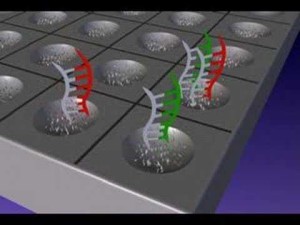A microarray is a multiplex lab-on-a-chip, It is a 2D array on a solid substrate that assays large amounts of biological material using high-throughput screening miniaturized, multiplexed and parallel processing and detection methods. A DNA microarray is a collection of microscopic DNA spots attached to a solid surface. DNA microarray is also commonly known as DNA chip or biochip. DNA microarray technology may be defined as a high-throughput and versatile technology used for parallel gene expression analysis for thousands of genes of known and unknown function, or DNA homology analysis for detecting polymorphisms and mutations in both prokaryotic and eukaryotic genomic DNA.
There are different types of Microarrays like:
Microarray Expression Analysis: This expression pattern is then compared to the expression pattern of a gene responsible for a disease.
Microarray for Mutation Analysis: For this analysis, the researchers use gDNA. The genes might differ from each other by as less as a single nucleotide base and detecting them is known as SNP detection.
Comparative Genomic Hybridization: It is used for the identification in the increase or decrease of the important chromosomal fragments harboring genes involved in a disease.
Microarray analysis involves breaking open a cell, isolating its genetic contents, identifying all the genes that are turned on in that particular cell, and generating a list of those genes.
Microarrays can be manufactured in different ways, depending on the number of probes under examination, costs, customization requirements, and the type of scientific question being asked. Arrays may have as few as 10 probes or up to 2.1 million micrometre-scale probes from commercial vendors.
DNA Microarrays will be widely applicable in Gene Discovery, Disease Diagnosis, Drug Discovery, Toxicological Research.
With the advent of new DNA sequencing technologies, some of the tests for which microarrays were used in the past now use DNA sequencing instead. But microarray tests still tend to be less expensive than sequencing, so they may be used for very large studies, as well as for some clinical tests.

